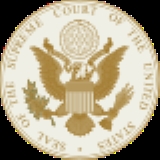
) appellate jurisdiction
over all state and federal courts
, and original jurisdiction
over a small range of cases. The Court, which meets in the United States Supreme Court Building
in Washington, D.C., consists of a chief justice
and eight associate justices
who are nominated by the President and confirmed by the Senate. Once appointed, justices have life tenure unless they are removed after impeachment
.
Under Chief Justices Jay
, Rutledge
, and Ellsworth
(1789–1801), the Court heard few cases; its first decision was West v. Barnes
(1791), a case involving a procedural issue.
1789 The United States Congress passes the Judiciary Act which creates the office of the United States Attorney General and the federal judiciary system, and orders the composition of the Supreme Court of the United States.
1790 In New York City, the Supreme Court of the United States attempts to convene for the first time.
1790 The Supreme Court of the United States convenes for the first time.
1803 In ''Marbury v. Madison'', the Supreme Court of the United States establishes the principle of judicial review.
1804 The Democratic-Republican-controlled United States Senate begins an impeachment trial against Federalist-partisan Supreme Court of the United States Justice Samuel Chase.
1841 The U.S. Supreme Court rules that captive Africans who had seized control of the ship carrying them had been taken into slavery illegally.
1857 Supreme Court of the United States rules in the Dred Scott v. Sandford case.
1879 Women's rights: American President Rutherford B. Hayes signs a bill allowing female attorneys to argue cases before the Supreme Court of the United States.
1893 The Supreme Court of the United States rules in ''Nix v. Hedden'' that a tomato is a vegetable, not a fruit, under the Tariff Act of 1883.
1895 In Pollock v. Farmers' Loan & Trust Co. the Supreme Court of the United States declares unapportioned income tax to be unconstitutional.

